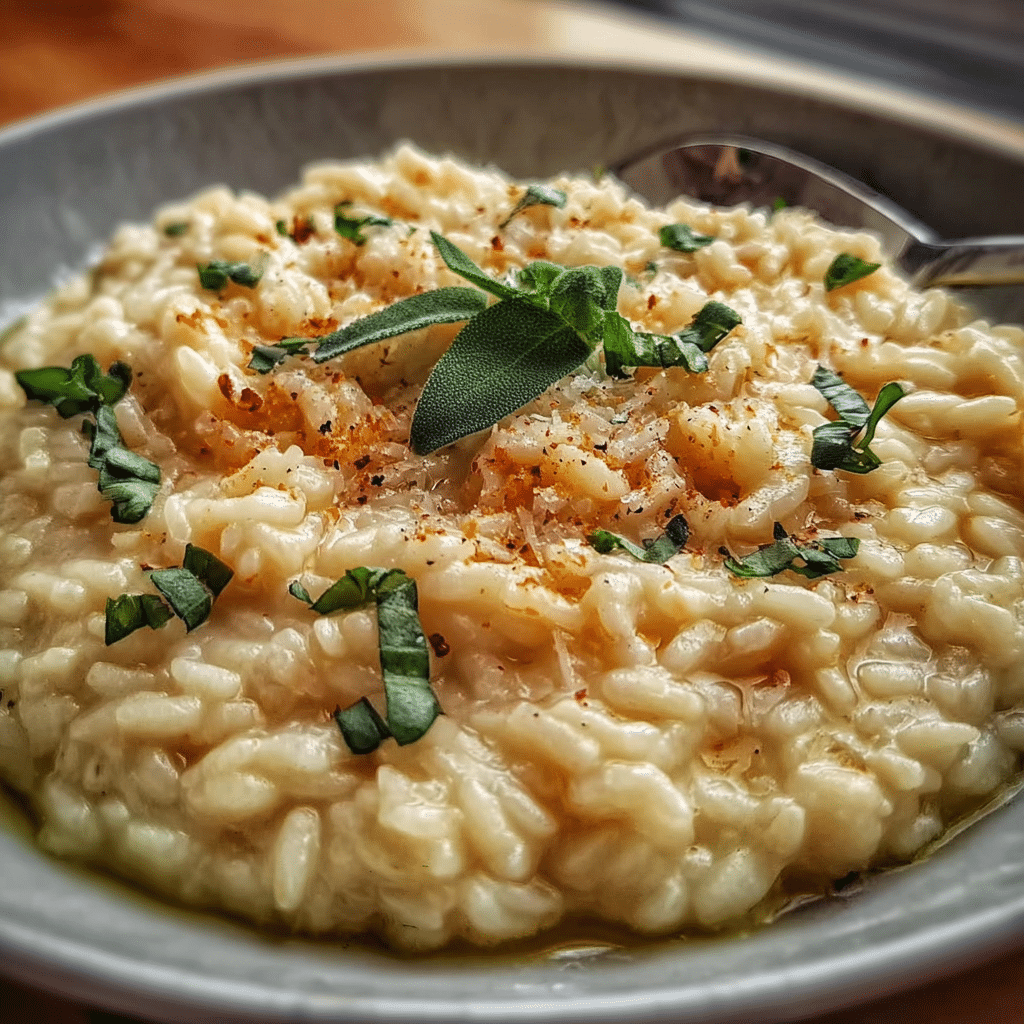Crockpot butternut squash has become a treasured dish in my home, a recipe that seamlessly blends convenience with health and comfort. I first stumbled upon this delightful creation during a particularly hectic week when life seemed to whirl around me faster than I could catch my breath. The autumn sun was starting to set earlier, and with the change of seasons, I longed for something warm and nourishing. I had a butternut squash sitting on my countertop, a gift from a friend’s garden, and apples that were beginning to soften in the fruit bowl. It was the perfect opportunity to experiment with my trusty crockpot.
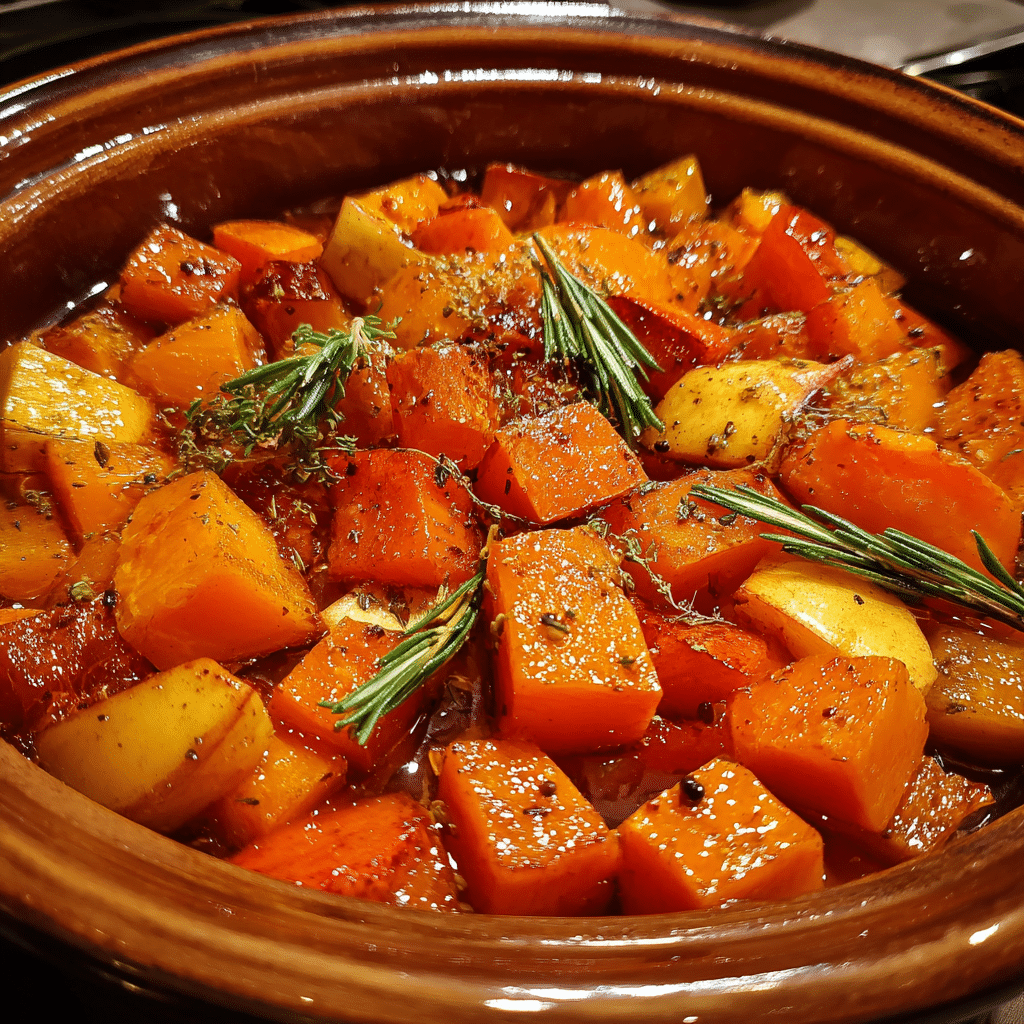
As I tossed the squash and apples into the pot, I felt a wave of nostalgia wash over me. My grandmother used to make a similar dish, albeit on the stovetop, filling the kitchen with an aroma that danced through our home. I could still hear her laughter as she would tell stories from her childhood, and as I prepared this meal, I realized I was not just cooking; I was honoring that memory. The combination of sweet apples and earthy squash simmering away in the crockpot filled my home with warmth, both in temperature and sentiment.
The Story Behind This Recipe
The beauty of crockpot butternut squash lies not just in its flavor but in its simplicity and versatility. This dish is a celebration of autumn’s bounty, showcasing the seasonal produce that fills farmers’ markets and grocery stores during this time of year. Butternut squash, with its creamy texture and sweet, nutty flavor, pairs perfectly with the tartness of apples, making this a harmonious dish that appeals to both adults and children alike.
What sets this particular recipe apart is the way it embraces the essence of slow cooking while allowing for flexibility. Whether you’re a busy parent juggling work and family or someone who simply wants a healthy meal without the fuss, this crockpot butternut squash recipe is a game changer. You can prep it in the morning, set the timer, and return home to a delightful, ready-to-eat dinner. It’s the perfect solution for those hectic weeknights when cooking feels like a chore rather than a joy.
Moreover, the seasonal relevance of this dish cannot be overstated. As the days grow shorter and the air turns crisp, there’s something incredibly comforting about a warm bowl of butternut squash and apples. This dish sings autumn, making it ideal for Halloween gatherings, Thanksgiving feasts, or simply a cozy family dinner. It invites you to slow down and savor the flavors of the season, reminding us to appreciate the simple pleasures in life.
Why You’ll Love This Dish
Crockpot butternut squash is not just a meal; it’s an experience. It brings people together, creating moments of connection and warmth around the dinner table. The emotional ties we form with food are profound; they can evoke memories, create traditions, and foster relationships. For me, this dish is a reminder of family gatherings where we shared stories and laughter, and it continues to be a staple in my home because it embodies love and care.
In this ultimate guide, you’ll learn how to create this delicious dish from scratch, including tips for selecting the best squash and apples, variations to suit your palate, and ways to enhance the flavors with spices and herbs. You’ll discover the magic of your crockpot and how it can transform simple ingredients into a comforting meal that nourishes both body and soul. So, gather your ingredients, and let’s embark on this culinary journey together, ensuring that crockpot butternut squash becomes a beloved recipe in your home as it has in mine.
The Rich History and Cultural Significance of crockpot butternut squash
The rich history and cultural significance of crockpot butternut squash are woven into the fabric of many communities, especially during the fall months when the harvest is abundant. Butternut squash itself, native to the Americas, has been cultivated since ancient times. It is a member of the gourd family, and its sweet, buttery flesh has made it a favorite among cooks for generations. The tradition of cooking with squash can be traced back to indigenous peoples who utilized it in various forms, from roasting to stewing, long before the arrival of European settlers.
Origins and History
Crockpot cooking, while a more modern invention, dates back to the late 20th century when busy families began seeking convenient meal solutions. The slow cooker, or crockpot, revolutionized home cooking by allowing meals to be prepared with minimal effort while retaining the flavors and nutrients of the ingredients. The idea of combining butternut squash with apples in a slow cooker is a natural progression, marrying these two ingredients that thrive in the same season.
Regionally, variations of butternut squash dishes can be found across the globe. In South America, for example, squash is often featured in hearty stews that incorporate local spices and meats. In the United States, particularly in New England, recipes featuring both apples and squash are common, reflecting the local produce and agricultural practices. These regional adaptations celebrate local flavors and traditions, showcasing the versatility of butternut squash.
Cultural Significance
In many cultures, butternut squash is associated with harvest festivals and Thanksgiving celebrations. It symbolizes abundance and gratitude, reflecting the importance of seasonal eating. Families often gather to prepare meals featuring squash during these occasions, creating a sense of community and togetherness. This cultural relevance adds depth to the crockpot butternut squash dish, as it becomes more than just food; it transforms into a shared experience that connects generations.
Famous chefs and restaurants have also embraced this dish, elevating it to new heights. Renowned culinary artists highlight the complex flavors of butternut squash in their menus, often pairing it with unexpected ingredients like sage, maple syrup, or even spices like cumin and coriander. These innovative approaches inspire home cooks to experiment and personalize their own versions of crockpot butternut squash, making the dish a canvas for creativity.
Nutritional Benefits
Beyond its historical and cultural significance, crockpot butternut squash offers numerous nutritional benefits. Butternut squash is low in calories yet packed with essential vitamins and minerals. It is a rich source of vitamin A, which promotes eye health, and vitamin C, known for its immune-boosting properties. Additionally, butternut squash is high in fiber, aiding digestion and contributing to a feeling of fullness, making it an excellent choice for those looking to maintain a healthy diet.
Apples, the perfect complement to butternut squash, bring their own health benefits to the table. They are rich in antioxidants and dietary fiber, supporting heart health and aiding in weight management. When combined in a crockpot dish, these ingredients not only create a flavorful meal but also provide a wholesome option for families seeking nutritious dinner solutions.
In conclusion, the crockpot butternut squash dish is steeped in history and culture, reflecting a beautiful blend of tradition and modern convenience. As you explore this dish in your own kitchen, you are not only participating in a time-honored culinary tradition but also nourishing your family with wholesome ingredients. Join me in celebrating the beauty of crockpot butternut squash and all that it represents.
Essential Ingredients for Perfect crockpot butternut squash
When embarking on the culinary adventure of crafting a delightful crockpot butternut squash dish, the ingredients you choose play a pivotal role in the flavor and texture of the final product. This dish, a harmonious blend of sweet and savory flavors, is not only nourishing but also a feast for the senses. Let’s explore the essential ingredients that will elevate your crockpot butternut squash experience.
Essential Ingredients
- 1 medium butternut squash (about 2-3 pounds) – The star of the show, butternut squash, has a sweet, nutty flavor that deepens when cooked. Look for squash that is firm, free of soft spots, and has a matte skin. The color should be a deep tan, indicating ripeness.
- 2 medium apples (preferably Granny Smith or Honeycrisp) – Apples add a lovely sweetness and a hint of tartness that balances the richness of the squash. Choose apples that are crisp and fragrant. Avoid those with bruises or blemishes.
- 1 medium onion – Onions provide a savory base that enhances the overall flavor profile. Look for onions that are firm and have a papery skin, avoiding any that feel soft or have dark spots.
- 3 cloves of garlic – Garlic infuses the dish with warmth and depth. Fresh garlic is essential; choose bulbs that are firm and do not show signs of sprouting.
- 4 cups of vegetable broth – This liquid is crucial for cooking the ingredients thoroughly and adding flavor. Opt for a low-sodium version to better control the saltiness of the dish.
- 1 teaspoon ground cinnamon – Cinnamon adds a warm, sweet spice that perfectly complements the squash and apples. Choose fresh, high-quality ground cinnamon for the best flavor.
- ½ teaspoon nutmeg – Nutmeg enhances the earthy tones of the dish. Like cinnamon, ensure your nutmeg is fresh for a more vibrant flavor.
- Salt and pepper to taste – Essential for bringing out the flavors of the other ingredients, use sea salt and freshly cracked black pepper for the best results.
- 2 tablespoons olive oil (optional) – While not necessary, a splash of olive oil can add richness and help caramelize the onions if sautéed first.
Each ingredient in this crockpot butternut squash recipe plays a crucial role, creating a symphony of flavors that is both comforting and nourishing. The butternut squash serves as the base, its creamy texture when cooked melding beautifully with the sweet notes of apples and the aromatic qualities of onion and garlic.
Print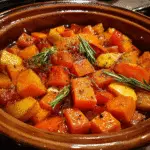
Crockpot Caramelized Butternut Squash and Apples
Ingredients
- 4 cups frozen diced butternut squash (one 20 ounce package)
- 4 apples, cored and sliced into bite-size pieces
- 1 cup dried cranberries
- 1 tablespoon cinnamon
- 1 ½ teaspoon nutmeg
Instructions
-
Combine all the ingredients in a slow cooker.4 cups frozen diced butternut squash,4 apples, cored and sliced into bite-size pieces,1 cup dried cranberries,1 tablespoon cinnamon,1 ½ teaspoon nutmeg
- Cook on high for approximately 90 minutes – 2 hours, stirring occasionally and checking the squash for tenderness.
- Once the squash is just about tender, switch to warm until it is time to serve. Don’t overcook or your squash will turn to mush (it will still be tasty, though!)
Shopping Tips
When shopping for your ingredients, consider the seasonality of butternut squash. This winter squash is typically in season from late summer through early winter, making it a perfect choice for fall and winter recipes. Apples, on the other hand, are harvested in the fall, but many varieties are available year-round. For the freshest options, visit local farmers’ markets or farm stands, where you can often find organic produce that is superior in flavor and nutritional value.
Quality indicators are essential when selecting your ingredients. For butternut squash, look for a heavy squash with a smooth skin. Apples should be firm and fragrant; the aroma can often indicate ripeness and sweetness. When it comes to onions and garlic, the fresher, the better. Avoid any ingredients that feel soft or look discolored, as they can adversely affect your dish.
Substitutions and Alternatives
While the ingredients listed above create a classic crockpot butternut squash dish, you may have dietary restrictions or preferences that necessitate substitutions. If you’re looking for lower-carb options, swap out the apples for a similar amount of cooked carrots, which will provide sweetness without the sugar content of apples. For those who are allergic to garlic, feel free to omit it or use garlic powder as a milder alternative.
Vegetable broth can be replaced with chicken broth for a heartier flavor, though it will no longer be vegetarian. If you’re aiming to reduce sodium intake, make sure to choose low-sodium broth or make your own at home. For the spices, fresh herbs like thyme or rosemary can add a different dimension to the dish, while also providing a fragrant aroma as they cook in the crockpot.
Storage is also a significant consideration. Whole butternut squash can be stored in a cool, dry place for several weeks, while once cut, it should be refrigerated and used within a few days. Apples can last in the fridge for a couple of weeks, but check them regularly for any signs of spoilage. Onions and garlic should be kept in a cool, dark place to maximize their shelf life.
Cost-saving tips include purchasing seasonal produce, which is often cheaper and fresher. Buying in bulk can also reduce costs, especially for pantry items like spices and broth. Additionally, consider growing your own herbs; they are easy to cultivate and can add a fresh flavor to your meals without breaking the bank.
In summary, the ingredients for your crockpot butternut squash recipe are not just about flavor; they also tell a story of seasonality, quality, and personal preference. Selecting the best ingredients will ensure that your dish is not only delicious but also a nurturing addition to any meal.
Detailed Step-by-Step crockpot butternut squash Cooking Instructions
Now that we have gathered our ingredients, it’s time to dive into the heart of the cooking process. Creating a delicious crockpot butternut squash dish involves a series of straightforward steps that ensure each ingredient shines through. With a bit of preparation and attention to detail, you’ll have a warm, comforting meal ready with minimal effort. Let’s break it down step by step!
Preparation Steps
- Gather Your Ingredients: Before you start, make sure you have all your ingredients on hand. This will streamline your cooking process and make it more enjoyable. You’ll need your butternut squash, apples, onion, garlic, vegetable broth, spices, and any optional ingredients you choose to use.
- Prep the Butternut Squash: Start by peeling the squash. A good vegetable peeler will do the trick, but be sure to apply even pressure to avoid slips. Once peeled, cut the squash in half lengthwise and scoop out the seeds using a spoon. Next, chop the squash into 1-inch cubes. The size is important for even cooking.
- Chop the Apples: Core and chop the apples into similar-sized pieces to the squash. This ensures they cook at the same rate. There’s no need to peel them unless you prefer them that way, as the skin adds fiber and nutrients.
- Prepare the Onion and Garlic: Dice the onion finely and mince the garlic. If you want to enhance the flavors, consider sautéing the onions in a tablespoon of olive oil until they are translucent before adding them to the crockpot. This step is optional but adds an extra layer of richness to the dish.
Cooking Process
- Combine Ingredients in the Crockpot: Add the cubed butternut squash, chopped apples, diced onion, and minced garlic into your crockpot. Pour in the vegetable broth, ensuring that all ingredients are submerged.
- Add Spices: Sprinkle in the ground cinnamon, nutmeg, salt, and pepper. Stir the mixture gently to ensure the spices are evenly distributed throughout.
- Set the Cooking Time: Cover the crockpot with its lid and set it to cook on low for 6-8 hours or on high for 3-4 hours. The longer the cooking time, the more the flavors meld together, resulting in a rich and hearty dish. If you opt for high heat, keep an eye on it to prevent overcooking.
- Check for Doneness: About 30 minutes before the cooking time is up, check the tenderness of the squash and apples. They should be fork-tender but not mushy. If you find them too firm, let them cook a bit longer.
Final Assembly
- Purée if Desired: For a creamier texture, you can use an immersion blender to purée the mixture directly in the crockpot. Alternatively, transfer the mixture to a blender and blend until smooth. This step is perfect if you prefer a soup-like consistency.
- Adjust Seasoning: Taste your crockpot butternut squash dish and adjust the seasoning if necessary. You may want to add a pinch more salt, pepper, or even a dash of apple cider vinegar for a tangy twist.
- Serve and Enjoy: Ladle the squash and apple mixture into bowls, garnishing with a sprinkle of fresh herbs like parsley or a dollop of yogurt for added creaminess. This dish pairs wonderfully with crusty bread or as a side to a protein of your choice.
Throughout this process, remember that cooking is as much about the experience as it is about the result. Don’t rush; take the time to enjoy the aromas and textures of your ingredients. And if you make a mistake, don’t fret! Cooking is a learning journey, and even the most seasoned chefs have their off days. Just keep tasting as you go and trust your instincts.
With these detailed instructions, you are well on your way to mastering the art of crockpot butternut squash. The beauty of this dish lies not just in its simplicity but in its ability to bring warmth and comfort to your table. Enjoy the process, and happy cooking!
Professional Tips and Techniques for crockpot butternut squash
When it comes to making crockpot butternut squash, there’s a world of flavor and texture waiting to be unlocked. This humble squash, when paired with apples and a few simple spices, transforms into a velvety, comforting dish that can be enjoyed in myriad ways. But before diving into the recipe, let’s explore some professional tips and techniques that can elevate your crockpot experience.
Professional Techniques
Using a crockpot opens up a treasure trove of possibilities, especially with crockpot butternut squash. The slow cooking process allows flavors to meld beautifully, creating a dish that’s rich and warm. Here are some advanced techniques to consider:
- Choosing the Right Squash: Look for butternut squashes that feel heavy for their size, with a smooth, tan skin and no blemishes. A ripe butternut squash is key to a sweet and rich flavor.
- Prepping the Ingredients: For an even more nuanced flavor, roast the butternut squash cubes for a few minutes before adding them to the crockpot. This caramelization enhances their sweetness and depth.
- Layering Flavors: Don’t just toss everything in the crockpot at once. Start with the apples and spices, then layer the butternut squash on top. This helps in building flavor profiles as the top layer will absorb the aromatic notes from below.
Troubleshooting Guide
Even seasoned cooks can face challenges when working with a crockpot. Here are some common issues and solutions when making crockpot butternut squash:
- Too Watery: If your dish turns out too watery, it might be due to too many apples or not enough thickening agents. Consider adding a tablespoon of cornstarch mixed with water towards the end of cooking to thicken it up.
- Overcooked Squash: If you find your squash mushy, try reducing the cooking time slightly. Remember, every crockpot heats differently, so checking your dish about an hour before the suggested cooking time is wise.
- Flavorless Result: If the dish lacks flavor, it might need more seasoning. Taste and adjust with salt, pepper, or even an extra dash of cinnamon or nutmeg.
Presentation Tips
Once you’ve mastered the art of making crockpot butternut squash, it’s time to think about how to serve it. Presentation can elevate even the simplest of dishes:
- Garnishing: A sprinkle of freshly chopped parsley, some toasted pumpkin seeds, or even a drizzle of balsamic glaze can add visual appeal and texture.
- Serving Style: Consider serving the dish in a hollowed-out mini pumpkin or on a beautiful platter. The rustic look complements the homely essence of the dish.
- Pairing with Beverages: A crisp white wine, like a Sauvignon Blanc, or a delightful cider pairs beautifully with the sweetness of the butternut squash and apples. For non-alcoholic options, consider a spiced apple cider that echoes the flavors of your dish.
For anyone looking to make-ahead or meal prep, the beauty of crockpot butternut squash lies in its versatility. You can easily double the recipe and freeze half for a busy weeknight meal. Just be sure to let it cool completely before transferring it to an airtight container. When you’re ready to enjoy, simply reheat on the stovetop or in the microwave.
Lastly, if you find yourself needing to scale your recipe up or down, simply adjust the quantity of squash and apples proportionately. The cooking time might need slight adjustments, so keep an eye on it. Cooking is all about intuition, so trust your instincts and enjoy the process!
Creative Variations and Adaptations of crockpot butternut squash
Once you’ve mastered the classic crockpot butternut squash recipe, it’s time to get creative! Variations and adaptations allow you to explore new flavor profiles and cater to different dietary needs. Let’s dive into the many possibilities that this delightful dish has to offer.
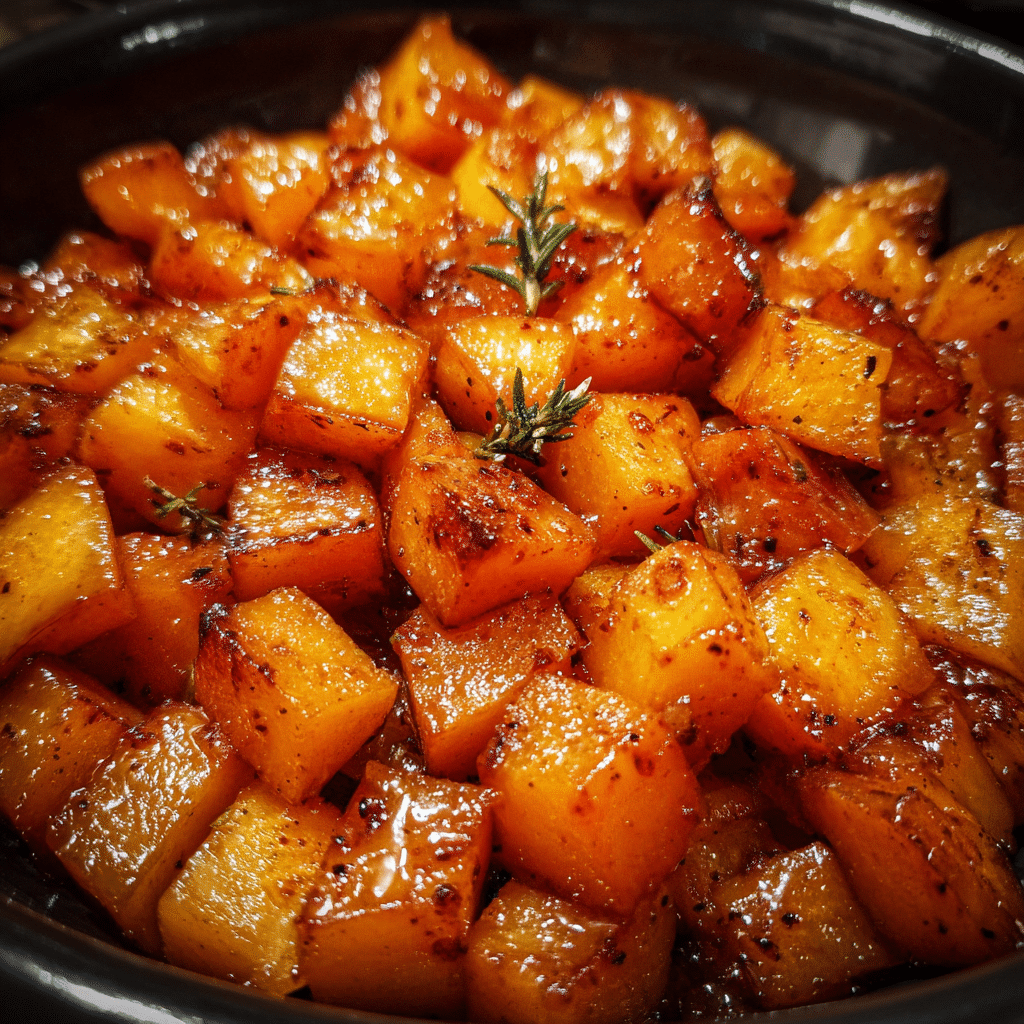
Seasonal Variations
The great thing about crockpot butternut squash is its adaptability to seasonal ingredients. As the seasons change, so can your dish:
- Fall Flavors: Incorporate ingredients like cranberries or pomegranates for a burst of tartness that complements the sweetness of the squash. Adding a pinch of sage or rosemary also brings a delightful earthiness to the dish.
- Winter Warmth: In winter, consider adding hearty root vegetables like carrots or sweet potatoes. These not only enhance the nutritional value but also create a more filling meal.
- Spring Freshness: When spring arrives, lighten the dish by adding fresh herbs like mint or basil, and even a touch of lemon zest to brighten the flavors.
Dietary Adaptations
Whether you’re catering to health-conscious friends or have specific dietary needs, crockpot butternut squash can be easily adapted:
- Keto-Friendly: Swap out the apples for lower-carb vegetables, like zucchini or cauliflower, and use a sugar substitute to keep the sweet notes.
- Vegan Options: This dish is naturally vegan, but you can enhance it with plant-based cream or coconut milk for a creamier texture.
- Gluten-Free: Rest assured, this dish is gluten-free as is! Just double-check any additional ingredients you may use.
Creative Twists
Why not experiment with international flavors? Here are some fusion ideas to jazz up your crockpot butternut squash:
- Indian Influence: Add curry powder or garam masala for a warm, spiced twist. Serve with a side of basmati rice or naan for a complete meal.
- Mexican Flair: Incorporate black beans, corn, and a touch of chili powder for a Southwestern take. Top with avocado or a dollop of sour cream for added richness.
- Italian Inspiration: Mix in some Italian seasoning and a splash of balsamic vinegar. Serve over pasta or as a side to grilled meats.
Leftovers can also be transformed into delicious new meals. Consider blending the leftover crockpot butternut squash into a creamy soup, or use it as a filling for quesadillas or empanadas. The possibilities are endless!
In conclusion, the versatility of crockpot butternut squash is truly remarkable. With a few tweaks and creative ideas, you can turn this dish into a weeknight staple or a festive centerpiece for gatherings. So embrace your culinary adventure and let your imagination run wild!
Storage, Reheating, and Meal Prep for crockpot butternut squash
When it comes to making a delicious crockpot butternut squash dish, one of the best aspects is its ability to be stored, reheated, and enjoyed later. Whether you’re meal prepping for the week or simply want to save some leftovers for another day, understanding how to properly store your crockpot butternut squash can make a world of difference in maintaining its flavor and texture.
Short-term Storage
After preparing your crockpot butternut squash, it’s essential to let it cool down before storing it in the refrigerator. This helps prevent condensation, which can lead to sogginess. I usually let it sit for about 30 minutes before transferring it to storage containers. For short-term storage, airtight containers work best. I prefer glass containers because they don’t absorb odors and keep the food fresh. You can use plastic containers, but make sure they are BPA-free and suitable for food storage.
Once you’ve transferred your crockpot butternut squash to the containers, label them with the date. Generally, the dish can be safely stored in the refrigerator for up to 4 to 5 days. If you know you won’t consume it within that timeframe, you might want to consider freezing it instead, which brings us to the next section.
Freezing and Long-term Storage
If you’re looking to store your crockpot butternut squash for an extended period, freezing is a fantastic option. To do this, make sure the dish has completely cooled down. Portion the squash into meal-sized servings in freezer-safe bags or containers. I always use the “squeeze and seal” method with freezer bags to remove excess air, which helps prevent freezer burn. It’s important to write the date on the bags—trust me, you’ll thank yourself later when you’re rummaging through the freezer!
Your crockpot butternut squash can typically be frozen for up to 3 months. While it can last longer, the quality may decline. When you’re ready to enjoy it again, simply thaw it in the refrigerator overnight before reheating. If you’re in a pinch for time, you can also thaw it in the microwave using the defrost setting.
Reheating Best Practices
Reheating your crockpot butternut squash properly is crucial to maintaining that delectable taste and texture you initially enjoyed. The best method for reheating is to use the stovetop or the microwave. If you’re using the stovetop, place the squash in a pan over medium heat. Add a splash of water or broth to keep it from drying out, and stir occasionally until it’s heated through. This method also allows you to adjust the seasoning if needed, perhaps adding a pinch of salt or a drizzle of maple syrup for an extra touch of flavor.
If you choose to use the microwave, place the squash in a microwave-safe dish, add a little water, cover it, and heat it in short intervals—about 1 to 2 minutes at a time—stirring between intervals until it’s heated to your liking. This method is quick and easy, but it may not be as effective at preserving texture compared to the stovetop method.
When reheating, always check the internal temperature to ensure it reaches at least 165°F (74°C) to guarantee food safety. This is particularly important if you’ve stored the dish for a few days or longer.
Meal Prep and Batch Cooking Strategies
Meal prepping with crockpot butternut squash is a game-changer for busy weeks. I often make a large batch of this dish on a Sunday, allowing me to have healthy meals ready to go when I’m crunched for time. Here’s my strategy: I make enough to last the week, dividing it into individual portions right after cooking. This not only makes it easy to grab and go but also helps control my portion sizes, which is beneficial for maintaining a balanced diet.
For those who enjoy variety in their meals, consider pairing your crockpot butternut squash with different proteins throughout the week—think grilled chicken, quinoa, or even a hearty grain salad. The versatility of butternut squash allows it to complement a wide range of flavors, so you can keep your meals exciting.
Food Safety Considerations and Guidelines
Food safety is paramount when storing and reheating your crockpot butternut squash. Always remember the “two-hour rule”—food should not be left out at room temperature for more than two hours. If you plan to store leftovers, make sure to refrigerate or freeze them promptly after they’ve cooled.
Additionally, be cautious of cross-contamination. Use clean utensils for serving and storing your dish to prevent any bacterial growth. For those who are sensitive to allergens, always check the ingredients used in your crockpot butternut squash recipe and ensure that your storage containers have been thoroughly cleaned.
Shelf Life Expectations
Understanding the shelf life of your crockpot butternut squash is crucial to enjoying it at its best. In the refrigerator, it typically remains fresh for about 4 to 5 days. When frozen, it can last for up to 3 months. However, for optimal taste and texture, I recommend consuming it within the first month of freezing. Always inspect for any signs of spoilage before consumption, such as off-smells or changes in texture.
Portioning and Packaging Tips
When it comes to portioning your crockpot butternut squash, consider how you plan to use it. If you’re preparing it for quick lunches, portioning into single servings makes it easy to grab and heat up. If you’re planning to use it as a side dish for family dinners, larger portions may be more appropriate. Using clear containers can help you see what you have at a glance, making it easier to plan meals throughout the week.
In conclusion, mastering the art of storage, reheating, and meal prep with crockpot butternut squash not only saves time but also enhances your culinary experience. By following these guidelines, you can enjoy your delicious dish with confidence, knowing that it will taste just as good as the day you made it!
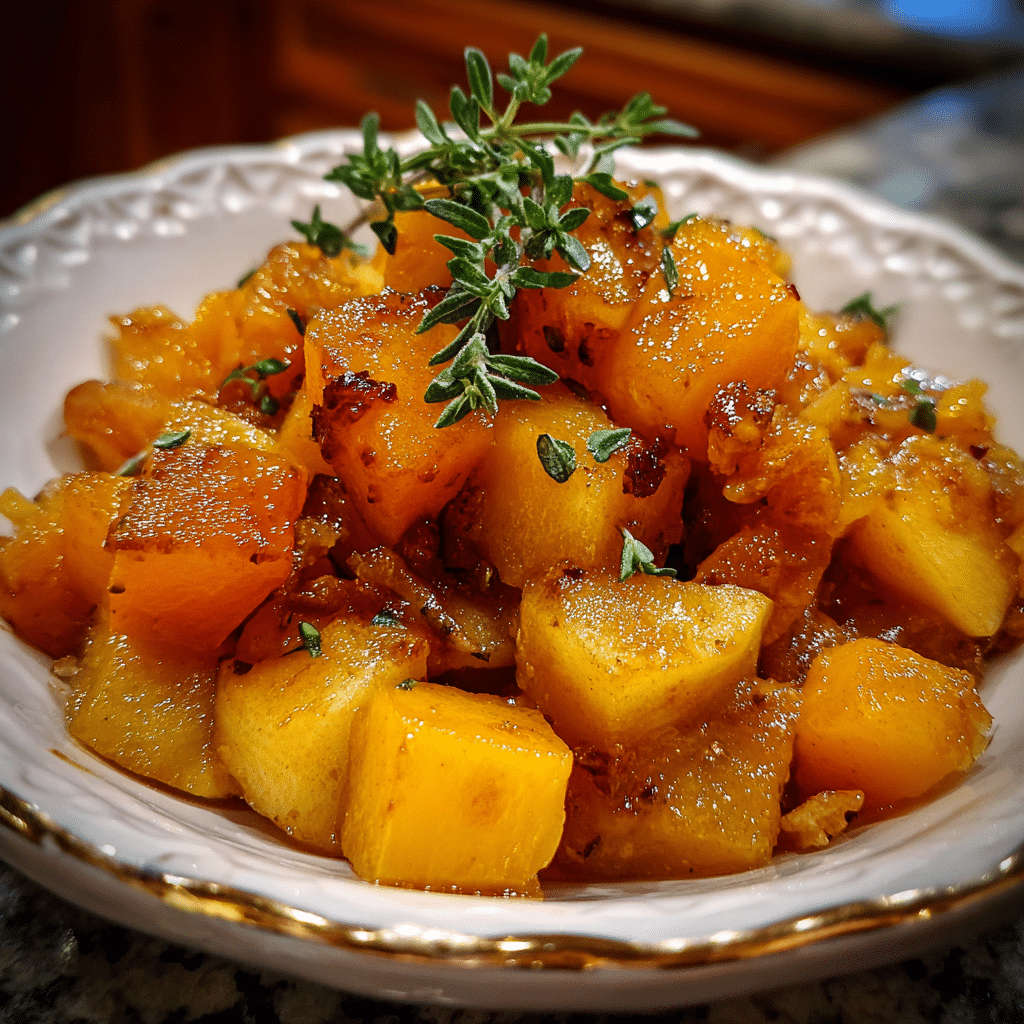
Nutritional Benefits and Health Information
As we delve into the nutritional benefits of crockpot butternut squash, it’s important to appreciate not just its delightful taste, but also the wealth of health benefits it brings to the table. Butternut squash, paired with apples in this charming dish, creates a symphony of flavors and nutrients that can support various dietary needs and health goals.
Nutritional Profile
Butternut squash is a nutrient-packed vegetable that is low in calories but high in vitamins and minerals. A one-cup serving of cooked butternut squash contains approximately 82 calories, 22 grams of carbohydrates, 2 grams of protein, and less than 1 gram of fat. It’s rich in dietary fiber, providing about 7 grams per serving, which is essential for digestive health.
One of the standout features of butternut squash is its impressive vitamin A content, primarily in the form of beta-carotene, which is crucial for maintaining vision and immune function. A single serving can provide over 200% of the recommended daily intake of vitamin A! Additionally, it contains significant amounts of vitamin C, magnesium, and potassium, all of which contribute to overall health.
When combined with apples, the nutritional profile becomes even more appealing. Apples are an excellent source of dietary fiber, particularly pectin, which can help lower cholesterol levels and improve gut health. They also provide vitamin C, potassium, and various antioxidants that contribute to heart health. The combination of butternut squash and apples not only offers a delicious flavor profile but also a powerhouse of nutrients that can support a healthy lifestyle.
Health Benefits
The health benefits of crockpot butternut squash are numerous. Due to its high fiber content, it aids in digestion and can help you feel more satiated, making it a fantastic option for those looking to maintain or lose weight. The antioxidants found in both butternut squash and apples, such as beta-carotene and quercetin, have been linked to reducing the risk of chronic diseases, including heart disease and certain types of cancer.
Moreover, the potassium found in butternut squash helps regulate blood pressure levels, which is beneficial for cardiovascular health. Magnesium, also abundant in butternut squash, plays a key role in muscle function, nerve function, and energy production. By incorporating this dish into your diet, you can give your body a healthy boost of essential nutrients.
Dietary Considerations
For those with specific dietary needs, crockpot butternut squash offers versatility. It’s naturally gluten-free, making it an excellent choice for those with celiac disease or gluten sensitivity. Additionally, it’s vegan and vegetarian-friendly, fitting seamlessly into plant-based diets. However, it’s essential to be mindful of added ingredients when preparing the dish. For instance, if you’re adding butter or cream, you may want to seek out alternatives to align with a dairy-free diet.
Calorie-conscious individuals will appreciate that this dish is low-calorie but filling, thanks to the fiber content. You can also modify the recipe to suit different dietary preferences, such as reducing the amount of added sugars or fats, making it a versatile choice for various eating plans.
When comparing crockpot butternut squash with similar dishes, such as creamy butternut squash soups or casseroles that may use heavy creams, this recipe stands out as a healthier alternative. It maintains the comforting essence of the season while keeping the calorie count low and the nutritional value high.
For those looking to make healthy modifications, consider using vegetable broth instead of cream for a lighter version or adding spices like cinnamon and nutmeg to enhance the flavor without adding extra calories. You could also throw in some leafy greens, like kale or spinach, to increase the nutrient density of the dish.
In conclusion, crockpot butternut squash is not just a delightful dish; it’s a treasure trove of health benefits and nutritional goodness. Whether you’re looking to add more vegetables to your diet, maintain a healthy weight, or simply enjoy a comforting meal, this dish checks all the boxes. Embrace the flavors and nutrients it offers, and you’ll be well on your way to a healthier lifestyle!
Frequently Asked Questions About Crockpot Butternut Squash
How do I make a simple crockpot butternut squash and apples recipe?
To prepare a simple crockpot butternut squash and apples dish, start by peeling and cubing 1 medium butternut squash and chopping 2-3 medium apples (Granny Smith or Honeycrisp work well). Place the squash and apples in the crockpot, add 1 tablespoon of cinnamon, 2 tablespoons of brown sugar or maple syrup, and a pinch of salt for flavor. Pour in about a half cup of apple cider or water to help with steaming. Cook on low for 6-8 hours or high for 3-4 hours until everything is tender. For a smoother texture, you can mash the mixture before serving!
What is an easy recipe for crockpot butternut squash and apples?
An easy recipe for crockpot butternut squash and apples involves minimal preparation. Simply dice a peeled butternut squash and core 2 apples, tossing them into the crockpot. Add 1 teaspoon of ground ginger and a tablespoon of honey for a touch of sweetness. You can also include a splash of orange juice for added brightness. Cover and cook on low for 6-8 hours or high for 3-4 hours, stirring occasionally to combine the flavors. This simple method allows the natural sweetness of the squash and apples to shine through!
How can I make a healthy crockpot butternut squash and apples dish?
To create a healthy crockpot butternut squash and apples dish, focus on using whole, natural ingredients. Start by combining diced butternut squash and chopped apples in your crockpot, and for seasoning, use fresh herbs like thyme or rosemary instead of sugar. You can add a small amount of cinnamon for warmth and flavor without the calories. Consider using vegetable broth or coconut milk as a base instead of apple juice to keep it light yet creamy. Cook on low for 6-8 hours or high for 3-4 hours, and enjoy this nutritious side dish that’s packed with vitamins!
What are some good butternut squash slow cooker recipes?
Butternut squash is incredibly versatile in the slow cooker, and there are many recipes to explore. Aside from the classic squash and apples, you can try a butternut squash soup by blending cooked squash with vegetable broth, onions, garlic, and a splash of cream after cooking. Another delicious option is a butternut squash and black bean chili—just combine diced squash with black beans, tomatoes, corn, and spices for a hearty meal. For a sweet twist, consider making a butternut squash casserole with oats, nuts, and maple syrup. Always ensure the squash is cooked until tender, and feel free to experiment with spices and herbs to suit your taste!
Conclusion: Mastering the Perfect crockpot butternut squash
Creating the perfect crockpot butternut squash is more than just following a recipe—it’s about understanding the techniques, ingredients, and cultural significance behind this beloved dish. Throughout this comprehensive guide, we’ve explored everything from the historical origins to modern variations, ensuring you have all the knowledge needed to make this recipe your own.
Whether you’re a beginner cook or an experienced chef, the techniques and tips we’ve shared will help you create a crockpot butternut squash that’s not only delicious but also meaningful. Remember that cooking is a journey of discovery, and each time you make this dish, you’ll learn something new.
We encourage you to experiment with the variations we’ve discussed, adapt the recipe to your dietary needs, and most importantly, share it with the people you love. Food has the incredible power to bring people together, and Crockpot Butternut Squash and Apples is the perfect dish to create lasting memories around your dinner table.


